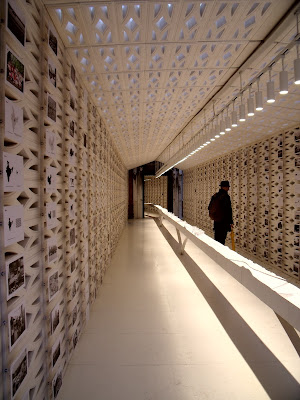"Singapore is capable of housing 6.5 million people. Singapore occupies only about 710 sq km. Multiply that by 1000, and it is possible to fit the entire population of the world into a land area approximately twice that of Italy, equal to Texas, one-fifth of India, and one-tenth of China. 1000 Singapores - A Model of the Compact City is also about the thousand faces of a high-density city-state - a portrait of the diversity of the living environment and the people who live in it. Ultimately, if 6.5 million people may be able to live sustainably on 710 sq km, this can offer a powerful model for the compact city of the future."The exhibition presented a physical model of the slice through Singpaore's landscape, with a selection of photographs and diagrams corresponding to the model.
 |
| The exhibition projected out of the main gallery space due to the length of the model. |
The information was presented in such a way that, despite the quantity of information on display, it was still digestible; with the relationship between the model and images clear without the need for any explanation. This was aided through the simple, reductive diagrams.
 |
| The simplicity of the space aided the reading of the information presented. |
Through the use of a linear, transversal trajectory through the entire city viewers were able to explore the changing physical/natural/urban/rural/built landscape and as such understand the city with more clarity (although admittedly through a reductive model).
 |
| Digital representation of the project. |
The exhibition ran from 26th August 2010 to 21st November 2010 at the Ground Floor Gallery Istituto Proviniciale per I'Infanzia, with an accompanying book. The online catalogue of the research, include the digital representation of the model is still available to view here.

No comments:
Post a Comment